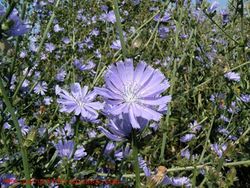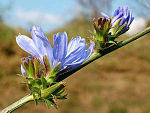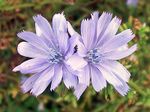Chicory
| Chicory |
|---|

|
| Scientific Classification |
|
| Species |
|
| Full view of C. intybus in the wild. |
Chicory is a herbaceous flowering plants belonging to the taxonomic genus cichorium. It is perhaps best known Chicory is a caffeine-free herb that is as a popular coffee substitute, as well as a traditional Southern US ingredient that can be added to coffee for a bolder, more intense flavor.
All of the species have fuzzy leaves and blue daisy-like flowers which grow mainly in the spring and summer in bunches of 2 to 4. Chicory is normally named biennial or perennial, depending on where it grows. Cichorium has many nutritional and medicinal uses, like improving bone density to relieving sinus problems.
Body Design
The cichorium species are annual woody herbs that are able to grow up to 1-2 feet (30.48-60.98 cm), with leaves and flower-heads on each node. They are found in swampy or desert environments and are most commonly found in Northern Africa. These species' stems are hairy, with stalked and unlobed leaves at the nodes. Wild chicory leaves are often bitter and added to salads, pastas, and meat dishes. Cichorium intybus, the most common chicory, has a bluish-purple flower in bunches of 2 to 4. It is also known as the blue dandelion, blue daisy, or coffeeweed. The flower is small, with the width reaching 0.5-1.5 inches (2-4 cm). The taproots of the cichorium species are sturdy and deep. The roots are ground and used for coffee or teas. Seeds are minuscule, brown, and wedge shaped. [3]
Life Cycle
Cichorium species are called both biennial (growing two years) and perennial (occurring more than two years), depending on the area which it grows. It is a dicot with a taproot that extends far down into the soil with a few smaller roots. Cichorium is known to grow leaves the first season from the seed. Its first growth occurs in late autumn through winter, and leaves begin to form during spring and summer, when flowering stems are produced for the blue, daisy-like flowers. It can only reproduce by its small, brown, wedge-shaped seeds, which are spread by primarily by wind, but can also be spread by insects and animals, water, and humans. In cold conditions, cichorium usually does not survive the winter, often killing the stems and roots, but does flourish in the springtime when sunny conditions are favorable. [4]
Ecology
Cichorium species originated in Mediterranean Europe, but has been popularized in Africa, North America, and Australia. Though it is called a weed in North America, it is named an endive (small, bitter-leafed vegetable) in Europe. It is found near roadways most often. Cichorium can tolerate most soils, but grows exceptionally well in soils rich with lime. [5] Cichorium intybus is able to grow in fertile soil or sandy loam, but grows optimally in a moist meadow soil with bountiful amounts of lime. Cichorium requires a lot of sunlight and must be kept in a sunny window or garden. [6]
Nutritional and Medicinal Uses
Wild cichorium leaves are bitter but can be reduced by soaking in water and removing the outer bark. The roots can be ground and used as a substitute for coffee or an addition to coffee grounds. The roots also contain oils that can be used to get rid of intestinal parasites. Cichorium roots have the same effect as Tanacetum vulgare on parasitic organisms. Chicorium plants have been used by farmers to get rid of parasites from their livestock. The use of cichorium in animals is much better than other ways to extract parasites because chicory is natural and can provide a flavorful taste to pork and beef.
The flower of chicory is noted as a folk medicine in Germany and is regularly used to treat sinus problems, gallstones, and gastro-enteritis. Additionally, it contains inulin, which benefits weight loss, bowel movements and constipation. Ingestion of the chicory flower can improve bone density due to its abundance in calcium.
Cichorium species are a popular additive for alternative remedies popular in Europe. [3]
Video
How to cook chicory for use as a coffee substitute.
Gallery
Although there are a handful of cichorium species, none of them have designated common names assigned to each species.
References
- ↑ No Author. Classification for Kingdom Plantae Down to Genus Cichorium L. United States Department of Agriculture. Web. Accessed: May 15 2015.
- ↑ Unknown Author. Cichorium Wikispecies. Web. Accessed: May 15 2015.
- ↑ 3.0 3.1 Jacinto, Valter, Wunderli, Michael. Chicory: cichorium intybus Encyclopedia of Life. Web.Accessed May 18, 2015.
- ↑ Hannaway, David B., Myers, Daniel. Forage Fact Sheet: Chicory Oregon State University. Web. Published: June 24, 2004.
- ↑ Cardina,John, Herms Cathy, Koch, Tim, Webster, Tim. Common Chicory Encyclopedia of Life. Web. Accessed May 18, 2015.
- ↑ Author unknown. Cichorium intybus Plants For A Future. Web. Accessed May 22, 2015.








